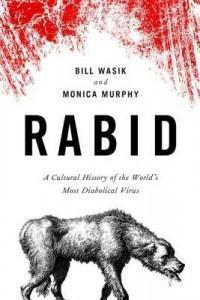- Book:
- Bill Wasik, Monica Murphy
Reviewed by: Donna Brown
- Rating:
- 4
Summary:
This is a simply fascinating review of the disease from a historical and cultural perspective.
More DetailsRabid: A Cultural History of the World's Most Diabolical Virus (2012) In the tradition of The Emperor of All Maladies and The Great Influenza, journalist Bill Wasik and veterinarian Monica Murphy chart the history, science, and cultural mythology of rabies. In the absence of vaccination—as was true for thousands of years, until the late nineteenth century—the rabies virus caused brain infections with a nearly 100 percent fatality rate, both in animals and humans, and the suffering it inflicted became the stuff of legend.
In the tradition of The Emperor of All Maladies and The Great Influenza, journalist Bill Wasik and veterinarian Monica Murphy chart the history, science, and cultural mythology of rabies. In the absence of vaccination—as was true for thousands of years, until the late nineteenth century—the rabies virus caused brain infections with a nearly 100 percent fatality rate, both in animals and humans, and the suffering it inflicted became the stuff of legend. The transmission of the virus—often from rabid dog to man—reawakened a primal fear of wild animals, and the illness’s violent symptoms spoke directly to mankind’s fear of the beast within. The cultural response was to create fictional embodiments of those anxieties—ravenous wolfmen, bloodsucking vampires, and armies of mindless zombies.
From the myth of Actaeon to Saint Hubert, from the laboratories of the heroic and pioneering Louis Pasteur to a journalistic investigation into the madness that has gripped modern Bali, Rabid is a fresh, fascinating, and often wildly entertaining look at one of the world’s most misunderstood viruses.
Amazon USAmazon UKGoodreadsReview: Rabid: A Cultural History of the World’s Most Diabolical Virus
My usual ratio of reading has been one non-fiction title for every ten fiction titles, but 2013 has seen me embark on a real non-fiction kick. In part I blame (or rather thank) this book.
Really, the book synopsis covers it perfectly: this is a book that takes you on a journey through the disease’s history, but not just via microscopes and petri dishes, labs and hospitals. Instead, this look at rabies really does bring together a wonderful blend of culture, history and science.
This is a simply fascinating review of the disease from a historical and cultural perspective. I haven’t read a book that approached a medical condition in this way before and I really enjoyed it. So much so, that 2013 seems to be the year of reversing my fiction:non-fiction ratio!
Verdict: 4/5
(Book source: netgalley)

